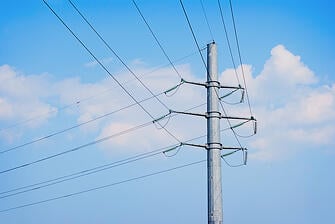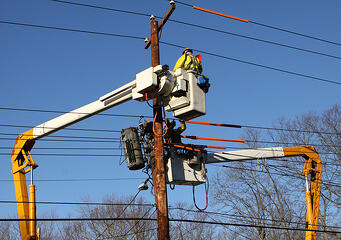 Serious injuries and fatalities caused by contact with high-voltage, overhead power lines are actually more common than you’d think ... both at work AND at home.
Serious injuries and fatalities caused by contact with high-voltage, overhead power lines are actually more common than you’d think ... both at work AND at home.
Roofers, heavy equipment operators, crane operators, tree trimmers, concrete mixer and pumper truck operators, dump truck drivers, employees of electrical sign companies, and workers using portable ariel lift equipment, bucket trucks, or ladders are just some of the professions exposed to the dangers of electric shock and electrocution.
At home, we’re exposed to these dangers when cleaning gutters, painting, pruning trees, or repairing the roof.
Because electricity seeks the path of least resistance, any situation that creates a conductive path from the overhead power line to the ground puts workers and homeowners in danger.
The foundation of a good loss prevention program is worker training and job pre-planning. During training, workers learn to recognize hazards so they can take precautions to avoid serious accidents. Before the job begins, necessary pre-planning helps identify the locations of overhead power lines, as well as the proximity of the work in relation to those lines. A good pre-plan will also determine the voltage of the power line in question and, if it’s windy, the possible sway of the line since this may affect safe clearance distances.
Controlling the electrical power line hazard begins when workers maintain a safe working distance, usually at least 10 feet. Depending on the voltage of the power line and wind conditions, however, this distance may need to be greater since electricity can arc through air.
In addition, if the air is more humid, or the equipment or materials are wet, the easier it is for electricity to arc and cause serious injury or even death. If workers can’t maintain a safe distance due to the work requirements, it’s important to contact the power company for an alternative solution. This may include protecting the power lines with insulated blankets or even temporarily de-energizing the power line and implementing a lockout/tag out procedure. If de-energizing is required, this is usually scheduled in advance, as it may impact service to local homes and businesses.
In some circumstances, dielectric-rated, non-conductive fiberglass poles are used to lift the power line temporarily so heavy equipment or materials can pass under it. The poles are rated for certain voltages and are labeled with working voltage capacities, so it’s imperative that workers know what current is in the line before using a rated dielectric pole. Only trained professionals should use dielectric-rated poles and other materials designed to come in contact with the electric power line. The poles should also be inspected for defects and kept dry, since water on the surface of the pole will conduct current that will pass through the user on the way to ground.
Ladders used near electric power lines should be constructed of non-conductive materials like fiberglass or wood, and be kept dry and in good condition. If a ladder must be repositioned, it should be done by taking down the ladder and carrying it horizontally. A ladder should never be extended vertically when moving.
Power lines are designed to prevent  grounding if they come in contact with tree branches; they’re not designed to protect humans. Most have limited, if any, insulation. Even insulated power lines can have insulation damage so if they’re contacted by a conductive material like an aluminum ladder, the electricity will take that path to ground.
grounding if they come in contact with tree branches; they’re not designed to protect humans. Most have limited, if any, insulation. Even insulated power lines can have insulation damage so if they’re contacted by a conductive material like an aluminum ladder, the electricity will take that path to ground.
Working around overhead power lines requires forethought about safe working distances, the voltage carried in the line, proper training, and the use of safe equipment. If workers cannot maintain safe working distances, the utility company should be contacted to insulate or de-energize the line.
High-voltage overhead power lines carry a lot of electrical energy. There’s no margin for error so knowing how to safely work around them can mean the difference between life and death.
This blog was written by Bill Nienaber, a Senior Loss Prevention Representative for West Bend.




